The mobile music streaming industry has experienced a fast growth within the last few years. According to Grand View Research, as of 2023, the music streaming market has reached $40.2 billion in its total value and is expected to grow further with a CAGR of 14.4% to 2030.
Online streaming services such as Spotify, which has more than 500 million monthly active users, demonstrate a shift from the traditional music listening ways. Since people want simple and efficient solutions to access vast music libraries and enjoy personalized listening experiences, similar platforms' demand remains high.
Overview of Spotify's Success
The following are the main factors contributing to Spotify's success. First, its appealing design makes its users fluent in the search and selection of songs from large databases and in finding new songs. Second, its use of algorithms ensures that users are entertained through the presentation of playlists based on individual usage patterns.
Furthermore, the app has both a free option and a paid one which attracts more users to the productivity of the app. Spotify has 615 million monthly active users. Since 2015, Spotify has witnessed a steady increase in the number of active users on a quarterly basis.
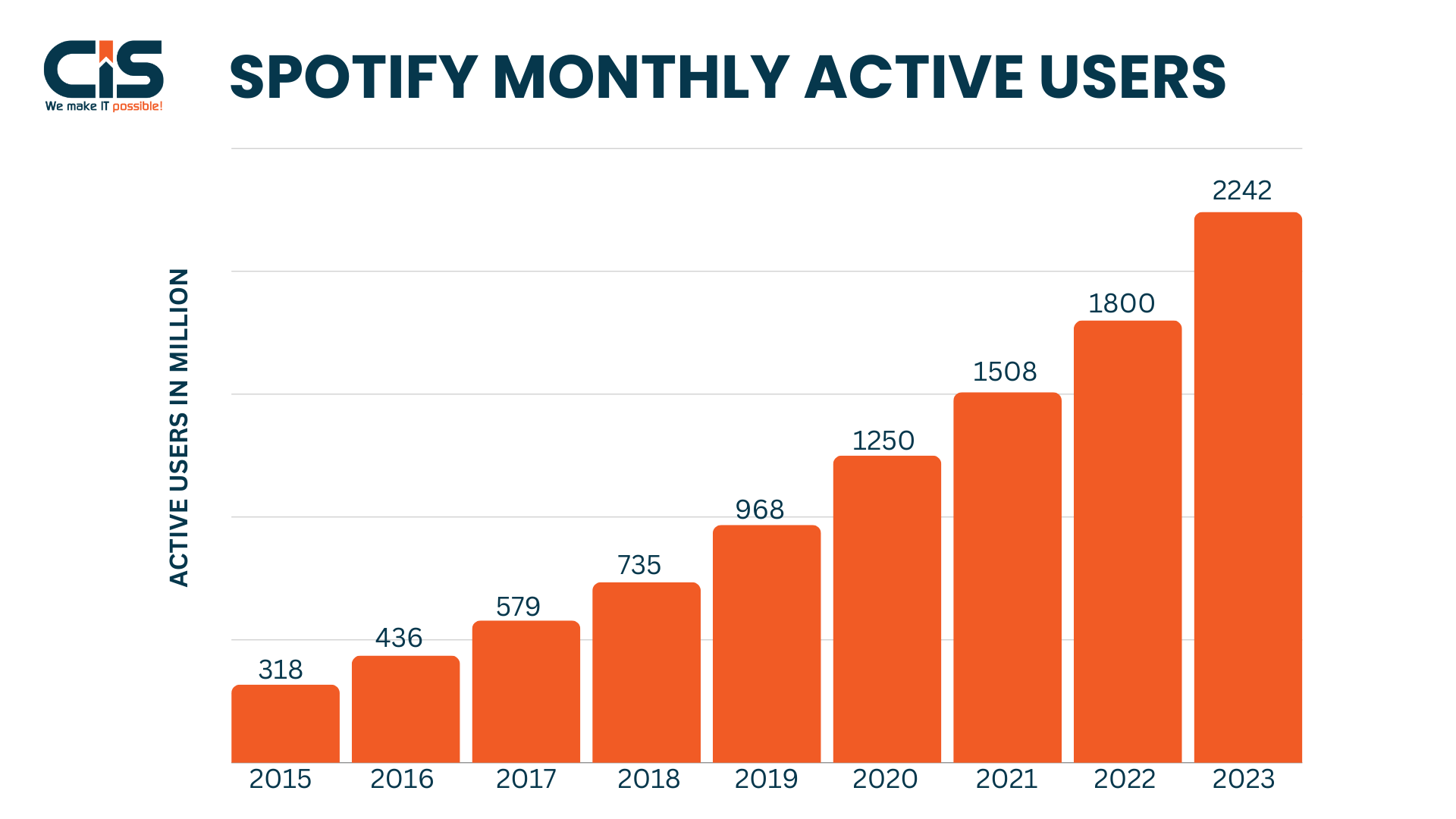
Spotify has maintained a good relationship with record labels and artists who are the key partners in delivering popular music content. By connecting independent artists directly through their audience and allowing them to capitalize on their work, Spotify has become a staple resource for both new and well-known musicians.
The Growing Demand for Music Streaming Services
Existing data on the increased popularity of consuming music products digitally indicates that the environment for startups in the music streaming market is favorable. Currently, more than three-quarters of music sales in the United States occur through streaming, and this trend has shifted from buying physical copies of music to downloading music.
More people want the ease of using a system that enables them to listen to their favorite products at any time from any location, creating opportunities for new entrants.
Moreover, the integration of podcasts, video content, and social media features into music platforms is becoming increasingly popular. As competition heats up among major players, the need for innovative features and user engagement strategies becomes crucial.
Creating a website similar to Spotify not only taps into a lucrative market but also has the potential for continuous growth and variety in service offerings.
By understanding how Spotify propelled itself to the top and recognizing the broader trends in music consumption, aspiring developers and entrepreneurs can lay the groundwork for their own successful music streaming app development.
Steps to Build a Website Similar to Spotify
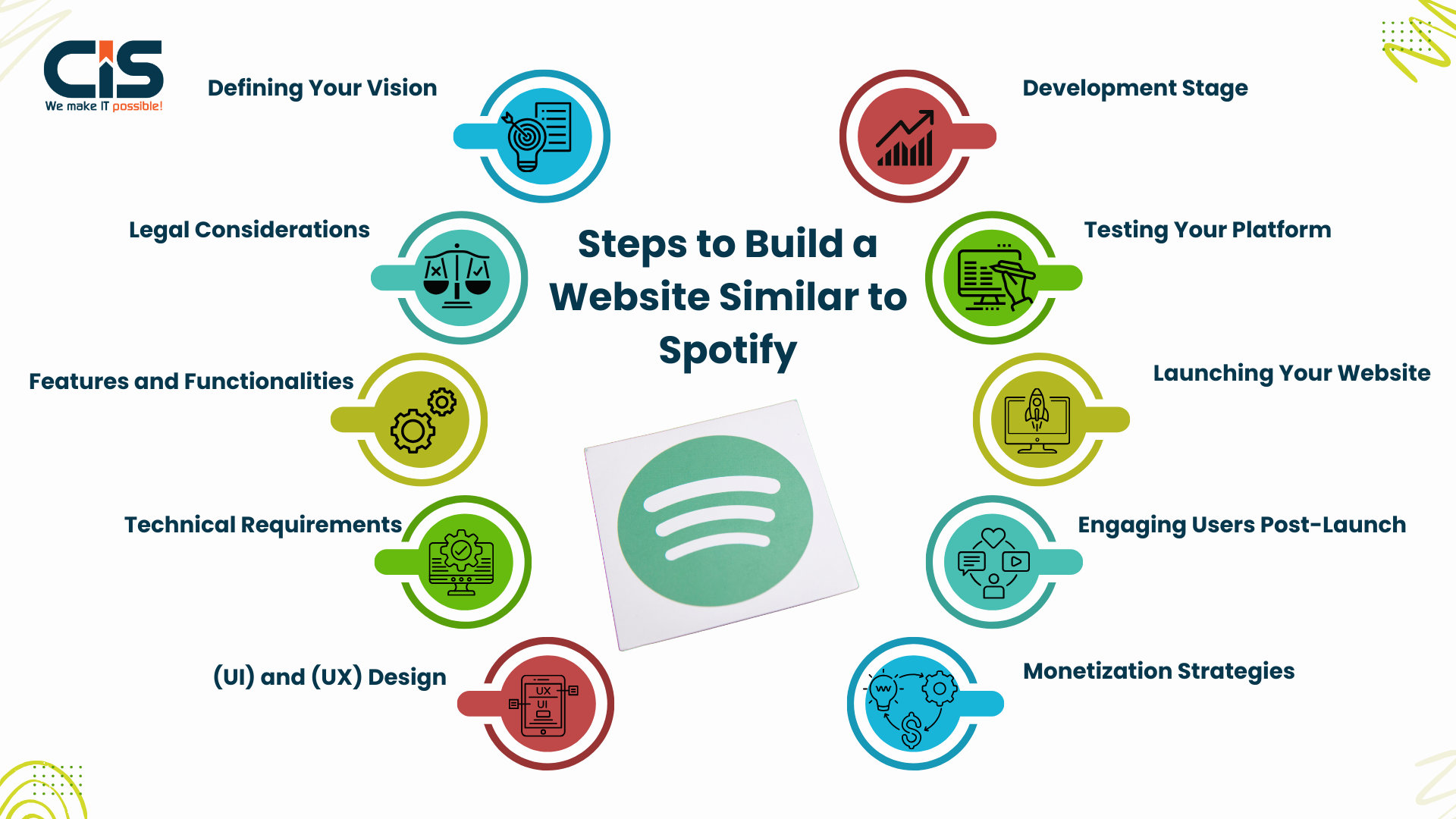
To create a website like Spotify, you need to focus on obtaining music licenses, designing an intuitive user interface, and developing a scalable back-end system to handle streaming and user data efficiently.
Step 1: Defining Your Vision
The foundation of creating a successful music streaming platform starts with a clear vision. Defining your vision for how to make a website like Spotify involves understanding the key features that contribute to its success and planning how to incorporate those elements into your own site. You need to establish your goals and the overall purpose of your website.
Identifying Your Target Audience
Knowing your target audience is essential for tailoring your content and features. Consider factors such as age, music preferences, and geographic location. Researching demographics will help you shape your platform's style, marketing approach, and music selection.
Clarifying Your Unique Selling Proposition (USP)
Your Unique Selling Proposition (USP) sets your platform apart from competitors like Spotify. Reflect on the basic features you plan to offer that competitors don't. These could include exclusive content, better discovery algorithms, or innovative user engagement tools. A strong USP will attract users and encourage them to choose your service over others.
Deciding on the Genre and Type of Music
It's important to define the genre or categories of music you want to feature. Will you focus on a specific niche, like indie music or international releases, or offer a broad catalog? Your decision will influence your marketing strategy, partnerships with artists, and user experience. Identifying your music genre also helps cater to the interests of your target audience.
Step 2: Legal Considerations
When building a Spotify clone, it's crucial to address all legal considerations, including intellectual property rights and licensing agreements, to ensure compliance and avoid potential legal issues.
As reported by the IFPI, the international recorded music market exceeded $23 billion in sales in 2021. This shows the potential revenues in this industry. However, to increase its popularity, the platform must comply with licensing and copyright laws
Understanding Licensing Requirements
Licensing is very important for any music streaming service provider. To ensure you have the legal means to stream music, it's essential to obtain the necessary licenses. Otherwise, you may get charged expensive legal fees that may slow down or halt your project.
Types of Music Licenses
There are several types of music licenses you'll need to consider:
- Mechanical Licenses: These enable you to broadcast or sell copyrighted music.
- Public Performance Licenses: These are necessary if you wish to perform music to the general public or via a network.
- Synchronization Licenses: These are required if you want to synchronize music with a video shoot to promote any product or service.
These licenses are crucial for realizing these services and your operations must comply with them when building a Spotify clone.
How to Obtain Licenses from Major Labels
To obtain licenses from major labels, you'll typically need to:
- Negotiate Terms: Enter negotiations with record labels to discuss the conditions of the licensing deal in terms of payments, such as per-stream rates.
- Join a Licensing Organization: In the United States, organizations such as the ASCAP, BMI, and SESAC can aid you in the acquisition of licensing and ease the process for you.
- Build Relationships: Purchase goods and services from music industry players after establishing good working relationships for more bargaining power.
Copyright Laws and Fair Use Policies
The aspects and rules governing copyright must be taken into consideration when creating your Spotify clone. Currently, in the U.S., musical works are protected by the Copyright Act, which grants the original author exclusive control over the work's contents. There are also fair use policies that allow limited use of brief sections of music without a license in specific circumstances. Although there are immense advantages of using Fair Use, it is not advisable to fully rely on it, one should consult a lawyer for a clear stand.
Setting Up Legal Frameworks
Establish a robust legal framework for your platform by:
- Consulting a Music Lawyer: Collaborate with an experienced lawyer who specializes in music and digital rights.
- Creating User Agreements: Draft clear terms of service and user agreements that outline how users can interact with your platform and the consequences of violating copyright policies.
- Implementing Reporting Systems: Create a system for rights holders to report copyright violations, ensuring that your platform remains compliant and protects artists' rights.
Step 3: Features and Functionalities
The music streaming industry thrives on delivering a seamless experience. To build a Spotify clone, focus on integrating essential features and functionalities, such as
Core Features of a Music Streaming Platform
- User Registration and Profiles: Simplifying the registration process is vital for user acquisition. Allow users to sign up using their email or social media accounts. User profiles should include customizable settings, favorite genres, and listening history, enabling a personalized experience.
- High-Quality Audio Streaming: Offer options for different audio streaming app quality levels. Users should be able to choose the streaming quality based on their internet speed, ensuring minimal buffering and a premium listening experience.
- Creating and Sharing Playlists: Enabling users to create, edit, and share playlists is essential. This feature can enhance user engagement and promote social interaction within the platform.
- Music Discovery (Search and Recommendations): Implement robust music discovery tools, including search functionality by song, artist, or album. Use algorithms to provide personalized recommendations based on user listening habits, helping users discover new music effortlessly.
- Offline Listening Capabilities: Allow users to download favorite tracks or playlists for offline availability. This feature is particularly appealing to those with limited data plans or who travel frequently, enhancing the platform's usability.
Additional Features for User Engagement
- Social Sharing and Interaction: Incorporate social media integration, allowing users to share their favorite tracks and playlists on platforms like Facebook, X, and Instagram. Additionally, enable comments or likes on songs or playlists to foster a community feel.
- Integrations with Other Apps: Consider partnerships with other applications such as social networks, productivity tools, or fitness apps. Integrating with popular platforms enhances the value of your service and draws in users who engage with those apps.
- Live Streaming or Podcast Capabilities: Expand your platform's offerings by including live-streaming events or podcast features. This will attract a broader audience, as many users are interested in exclusive content and live performances.
Step 4: Technical Requirements
Building a website like Spotify requires a solid technical foundation. Knowledge of the elements discussed below will enable you to establish a strong base to serve a huge number of users and accommodate a massive music collection.
Choosing the Right Tech Stack
Frontend Technologies:
The front end of your music streaming service is the part with which users engage directly. HTML, CSS, and JavaScript are mandatory to develop an attractive and dynamic web page to attract users. HTML structures the content, CSS classes it to enhance its appearance, and JavaScript adds interactivity and functionality to deliver an excellent user experience.
Backend Frameworks:
For the backend context, there are such options as, instance, Node.js, JS, Django, and Ruby on Rails. Node.Js is an excellent choice for dealing with numerous connections simultaneously, so it is a good option for frequently used services. Django is considered more secure than other frameworks and has many built-in components. Different frameworks have different abilities and characteristics which can be used based on what kind of project you are dealing with.
Database Management Systems:
Choosing the right DBMS is important for storing user details, playlists and music files. MySQL is well-suited for storing structured data, while MongoDB is efficient for unstructured data, offering flexibility for growth.
Cloud Storage Solutions for Music Files
Sharing individual music files requires three conditions: sufficient storage space, easy access, and the ability to listen without limitations on space or geographical location. Currently, there are many storage services, such as Amazon Cloudfront S3 or Google Cloud Storage, that are perfect for this purpose. They offer accessibility features, which allow users to listen to their favorite songs without limitations.
Streaming Protocols and Content Delivery Networks (CDN)
To improve the quality of streaming, use streaming protocols like HLS or DASH as a streaming profile. Another requirement for efficiently delivering music files is a Content Delivery Network or CDN. CDNs cut on the latencies and guarantee high availability, allowing the users to continue playback of video from any geographical location.
Step 5: User Interface (UI) and User Experience (UX) Design
Importance of UI/UX in Music Streaming
In the competitive landscape of music streaming, user interface (UI) and user experience (UX) are critical elements that can make or break a platform. A well-designed UI creates an attractive and intuitive layout that engages users and enhances navigation.
According to a study by Forrester Research, a well-crafted UX can increase user retention rates by 400%. This is vital for platforms like Spotify, where users have an abundance of options. A seamless experience encourages users to explore more features and spend more time on the platform, thereby increasing overall engagement.
Analyzing Design Inspirations (References from Spotify)
When designing a music streaming website like Spotify, studying industry leaders can provide valuable insights. Spotify's design is characterized by its dark theme, vibrant album art, and organized playlists. The interface is simple yet effective, allowing easy access to songs, playlists, and recommendations.
Key components to observe include the balance between aesthetic appeal and functional efficiency. For instance, the layout maximizes screen space and minimizes clutter, making it easier for users to focus on their music. Consider adopting similar strategies to enhance your Spotify-like website's design.
Wireframing and Prototyping Your Website
Before diving into the coding phase, wireframing your website is essential. Wireframes act as blueprints, offering a visual guide for layout and function. Tools like Figma, Sketch, or Adobe XD can help you create detailed wireframes that outline your design elements.
Focus on key features such as the home page, music player, and playlists. Once your wireframe is set, move on to prototyping. Prototypes are interactive models that simulate user interactions, allowing you to test the flow of navigation and functionality.
This stage is critical for identifying usability issues before significant resources are invested in development.
Ensuring Mobile Responsiveness
With over 50% of global web traffic coming from mobile devices, ensuring that your music streaming website is mobile-responsive is essential.
A responsive design adjusts seamlessly to different screen sizes and orientations, providing an optimal viewing experience regardless of the device being used. Google's mobile-first indexing emphasizes the importance of mobile compatibility for search rankings; therefore, a mobile-responsive site not only improves the user experience but also enhances its SEO performance. Utilize frameworks like bootstrap wireframing or CSS media queries to develop a responsive design.
Also Read: How to Build a Website Like Google?
Step 6: Development Stage
Creating a music streaming website like Spotify requires a solid development plan. This stage involves several crucial components, including building the front and back ends, integrating music library APIs, setting up payment systems for subscriptions, and enhancing security measures.
Building the Frontend and Backend
The frontend is what your users will interact with. It includes everything from the visual elements to user navigation. Using technologies such as HTML, CSS, and JavaScript can help you create an engaging and responsive user interface for a Spotify-like website. For styling and structure, frameworks like React or Angular are popular choices for creating dynamic and responsive web applications.
On the other hand, the backend is all about server-side operations. It includes database management, user authentication, and handling server requests. Languages such as Node.js, Python, or PHP are common for backend development. Your database, which could be SQL or NoSQL, will store essential user data, playlists, and song information.
Integrating Music Library APIs
To provide a vast selection of songs, you can leverage existing music library APIs, such as Spotify's Web API or Apple Music API. These APIs give you access to music metadata, playlists, and user accounts, enabling you to create a rich user experience without building a music library from scratch. Make sure to familiarize yourself with the API documentation and understand the data limits and usage policies.
Setting Up Payment Systems for Subscriptions
For a revenue generation model, implementing a reliable payment system is key. Consider using established payment gateways like Stripe or PayPal to handle subscription management, billing, and secure transactions. Ensure users can easily sign up, manage subscriptions, and experience transparent billing. Offering different subscription tiers, such as free and premium options, can attract a wider audience.
Enhancing Security (SSL, Data Protection)
User data security should be a top priority. Implementing SSL certificates ensures that data transferred between your users and the server is encrypted and secure. Additionally, employ strategies such as secure password storage, two-factor authentication, and regular security audits to protect user accounts from unauthorized access.
Data protection regulations like GDPR require transparency regarding how user data is collected and used. Make sure to establish a clear privacy policy that complies with applicable laws to build trust with your users.
With these components in place, you'll be well on your way to developing a functional and secure music streaming website that rivals industry leaders like Spotify.
Step 7: Testing Your Platform
Before launching your music streaming website, it's crucial to dedicate time to quality assurance (QA). According to a study by the Quality Assurance Institute, 80% of software projects fail due to insufficient testing. This highlights why a solid testing strategy is essential for your platform's success. A well-tested platform will help to ensure a smooth user experience, enhance satisfaction, and minimize post-launch issues.
Importance of Quality Assurance
Quality assurance helps identify bugs and usability problems before your site goes live. A reliable testing phase reduces downtime, improves performance, and fosters trust among users. In a competitive market where platforms like Spotify set high standards, ensuring that your website functions seamlessly is non-negotiable.
Types of Testing to Consider
Several testing methodologies should be implemented to cover all aspects of your platform:
Functional Testing:
Functional testing verifies that all features work as intended. This includes checking user registration, login processes, and playlist creation. Make sure every function aligns with user expectations and operates predictably. This can be done through automated tests or by creating manual scenarios that replicate real user actions.
Usability Testing:
Usability testing evaluates the user experience of your website. Gather a small group of potential users to interact with your site and provide feedback. Pay close attention to navigation, layout comprehension, and how intuitively users can access features. A user-friendly website like Spotify encourages more frequent engagement.
Performance Testing:
Performance testing assesses how your platform performs under various conditions. It evaluates load times, responsiveness, and server behavior during peak usage. Tools such as Apache JMeter or LoadRunner can simulate traffic to identify bottlenecks and optimization needs, ensuring your service can handle high volumes of users without glitches.
Gathering User Feedback for Improvements
Post-testing and facilitating user feedback create a loop for continuous improvement. Consider implementing surveys, feedback forms, or monitoring user behavior analytics to identify pain points. Engaging with early users provides invaluable insights that can inform adjustments and upgrades, resulting in a final product that aligns better with audience expectations.
Step 8: Launching Your Website
Launching a website similar to Spotify is a significant milestone that requires careful preparation and execution. According to Statista, as of 2023, over 650 million people used music streaming services globally, which illustrates the immense market potential. However, entering this competitive space demands a well-thought-out launch strategy.
Preparing for Launch Day
Getting ready for launch day involves several key steps to ensure a smooth debut. First, conduct a final review of your platform to fix any last-minute bugs or usability issues. Ensure all features are working correctly and that your server can handle the anticipated traffic surge.
Next, prepare your team. Make sure everyone understands their roles for launch day, from customer support to tech troubleshooting. Having a plan for managing potential issues will help alleviate chaos as users start signing up.
Food and Technology Preparation
If you plan to have an in-office launch event or virtual gathering, consider offering food and drinks. Providing refreshments can create a celebratory atmosphere and keep your team energized during the launch. Simultaneously, ensure your technology is set up for a successful launch. Test your hosting service's capabilities and consider backup systems to handle unexpected traffic spikes.
Marketing Strategies for Initial User Acquisition
To attract users right from the outset, implement comprehensive marketing strategies. Here are several tactics to consider:
- Social Media Campaigns: Utilize platforms like Instagram, X, and Facebook to create buzz around your launch. Create engaging content, including teaser, music videos and countdown posts. Hashtags can help increase visibility and encourage users to share your content.
- Influencer Collaborations: Partner with influencers in the music or tech space. Their established audiences can provide significant exposure for your Spotify-like platform. Offer them early access to your service in exchange for reviews and promotions. This tactic can build initial credibility and interest.
- Email Marketing Strategies: Build an email list before your launch and keep potential users engaged with informative content. Send exclusive previews, special launch announcements, and promotional offers to encourage sign-ups right from the start. A personalized email campaign can create a sense of urgency and excitement.
Step 9: Engaging Users Post-Launch
Building a Community Around Your Platform
After launching your music streaming website like Spotify, it's crucial to foster a community that keeps users engaged. Research indicates that platforms with a strong community see user retention rates increase by up to 30%. Create forums or social media groups where users can discuss music, share playlists, and connect with their favorite artists.
Encourage interaction through features like following friends, sharing songs, and commenting on playlists. This not only makes users feel valued but also enhances their overall experience on your platform.
Maintaining Interactive Features
Interactive features are essential for engaging your audience long after your Spotify-like website's launch. Integrate elements like live chat rooms, music quizzes, or polls where users can express their preferences and opinions.
Additionally, consider adding gamification-rewards for listening, sharing, or participating in challenges. According to a study, platforms that incorporate gamification see a 20% increase in user interaction. These features can motivate users to return regularly while creating a vibrant, interactive environment.
Regular Content Updates
Content is key in the music streaming business. Users expect fresh music regularly to keep them interested and coming back. Aim to update your library with new releases, trending songs, and curated playlists drawn from different genres.
A study by Nielsen revealed that 70% of users prefer platforms that constantly provide new content. Consider partnering with artists for exclusive releases or hosting live sessions to keep your content dynamic and appealing.
User Engagement Strategies
Engaging your users effectively requires an ongoing strategy. Analyze user activity and preferences with data analytics. Send personalized notifications about new releases based on listening history or create tailor-made playlists. Email campaigns can also be beneficial-regular newsletters highlighting new features, artist spotlights, or curated collections can maintain user interest. Research indicates that personalized marketing can increase user engagement by up to 50%.
Step 10: Monetization Strategies
There is significant potential for centrality in the music streaming business, which is projected to add $34 billion by 2030, primarily through new monetization models. To design a website similar to Spotify, several effective monetization strategies can be employed, and some of those are mentioned below:
Subscription-Based Models
This is a widely used business model in the streaming industry, where services are provided based on a subscription fee. In this model, customers subscribe for a monthly or annual fee, and in return, they get some rights that include ad-free listening, content downloads, and other exclusive benefits.
According to available statistics, websites with subscription-based monetization schemes retain about 90% of the users. This strategy allows companies to host different prices for their services, appealing to different users and encouraging them to upgrade to a higher level of subscription.
Freemium Models
Freemium models draw more users due to their free access to the service but with restricted functions. This setting provides an opportunity to study the capacities of your platform without any commitment. Once they subscribe, you can promote the paid version by highlighting what the subscribers are missing in the free version.
Policies indicate that around 30% of monthly active users become free users, and 30% of these free users ultimately pay, making this model good for expansion.
Advertising Revenue Streams
Basically, advertising can be an important source of income, especially when the platform has a large number of users. Offering a free rate allows you to monetize the Spotify-like platform, mainly through ads. Analysis of the advertising expenditure shows that digital audio track shares will be above $4 billion by 2025 and thus offer a good business chance. However, avoid placing too many ads, as this may interfere with the user experience.
Best Practices for Retaining Users
The stronger the users' loyalty, the higher the chance that monetization activity will bring the expected revenue. The following are some recommended procedures:
- Personalized Experiences: Recommend users-related playlists and content that align with their interests to ensure that their needs are well addressed.
- Engagement Through Communication: Providing users with updates on new app features, artists, and notifications will encourage them to keep coming back.
- Regular Updates: It is recommended to keep the music and related library updated to keep the users engaged.
- Community Building: Leads to the creation of forums or social media groups that foster a sense of community. Interacting with other users enhances the experience and encourages them to stay engaged with the app.
How Much Does It Cost to Build a Music Streaming App Like Spotify?
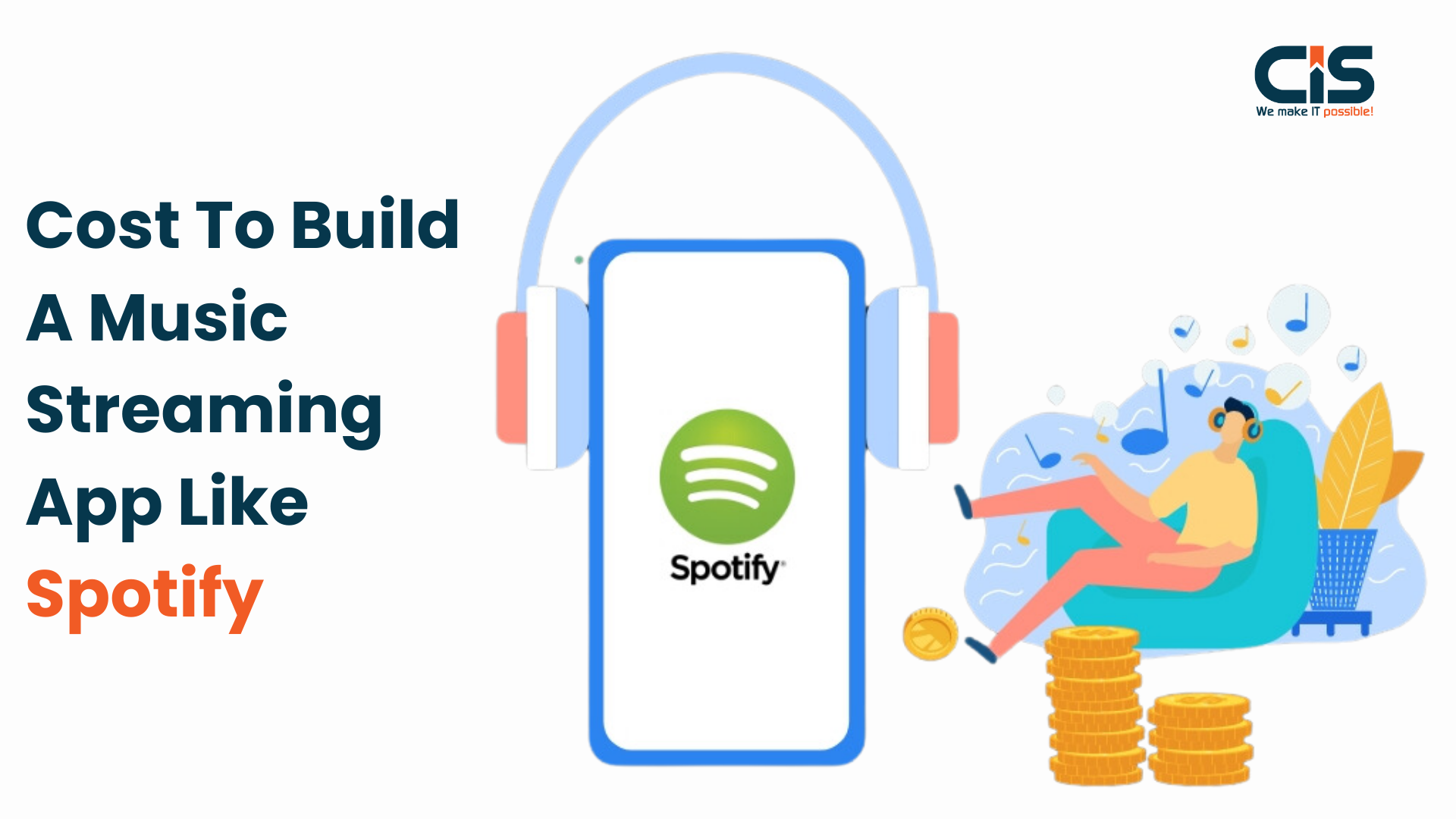
Creating a music streaming app similar to Spotify involves understanding the process of building a platform like Spotify and estimating the costs involved.
Key Cost Components
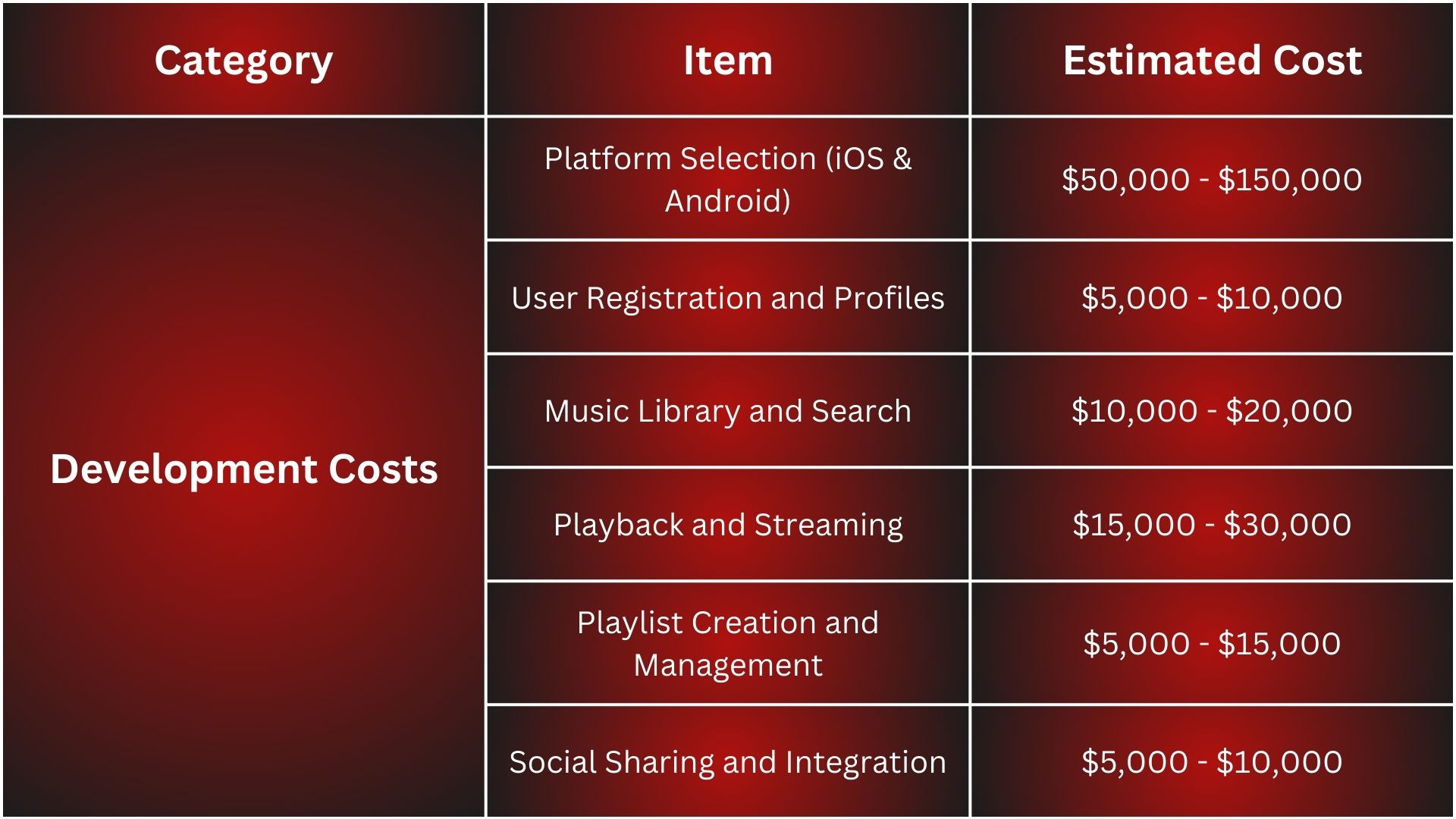
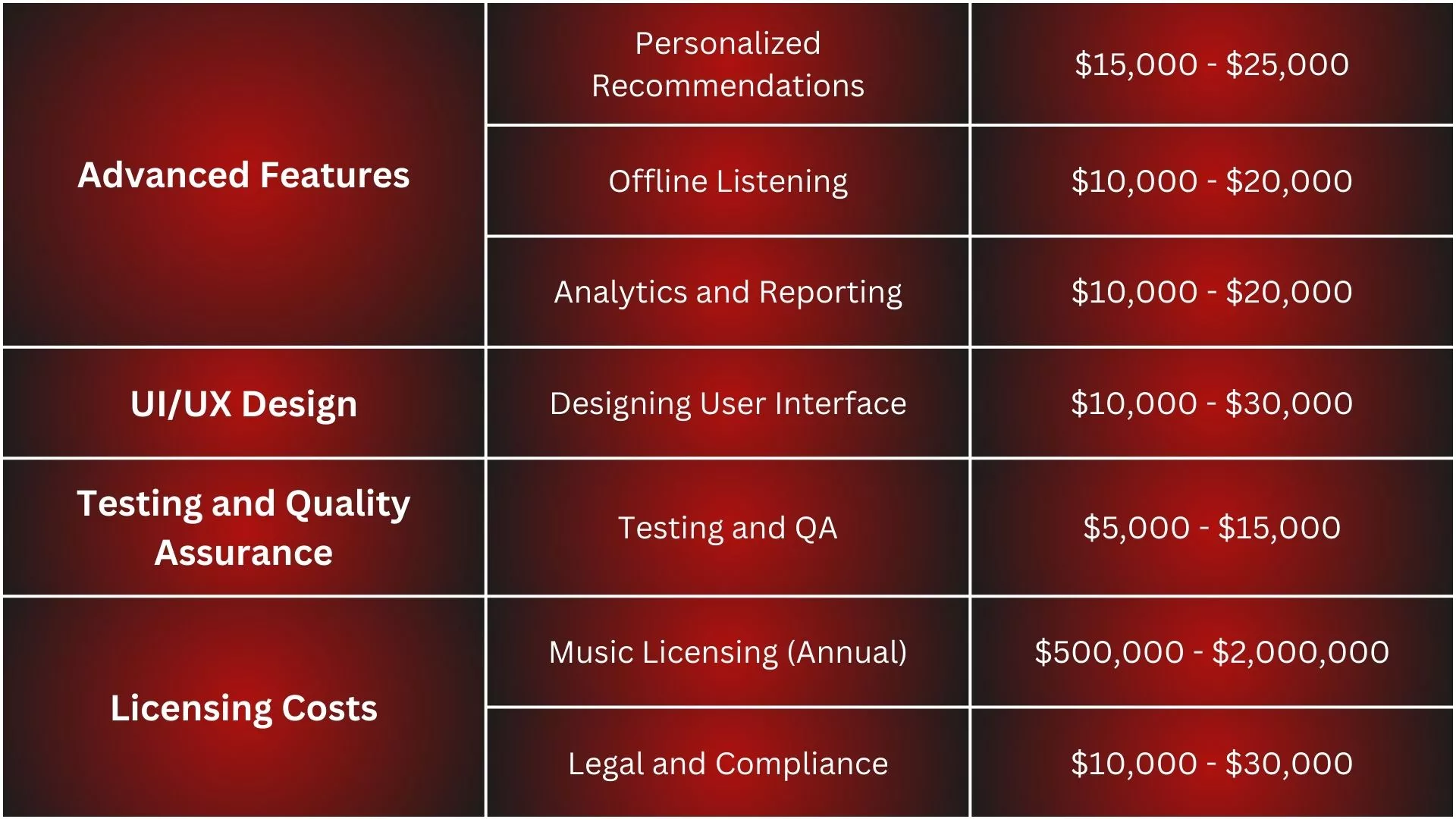
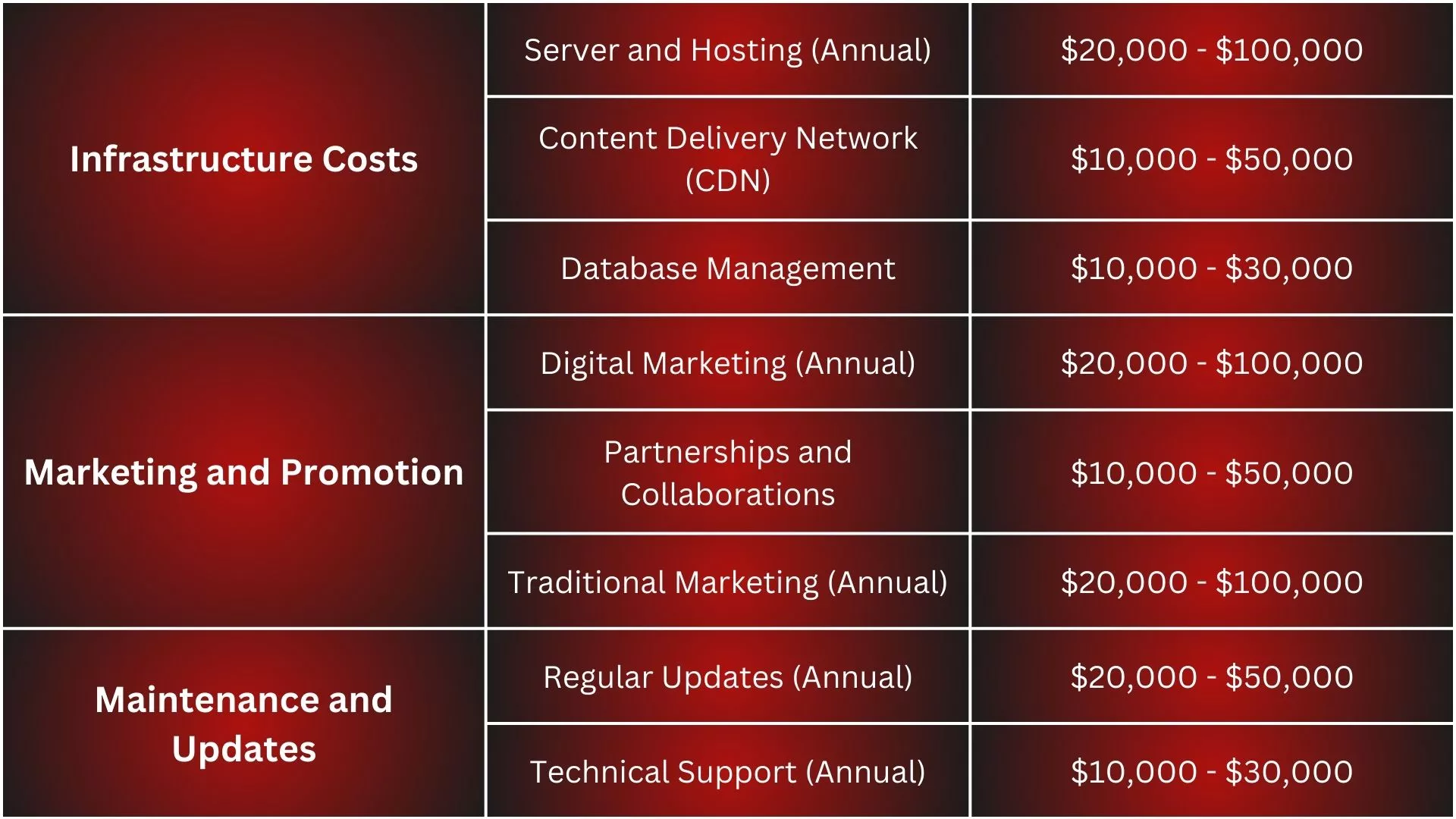
Total Estimated Cost
- Basic App: $150,000 - $300,000
- Advanced App with Comprehensive Features: $500,000 - $1,000,000+
Conclusion
Creating a website like Spotify involves a blend of strategic planning, robust technology, and an understanding of user preferences. By focusing on essential features, implementing effective monetization strategies, and prioritizing user retention, you can develop a platform like Spotify that resonates with music lovers.
The steps outlined-from choosing the right technology stack to building an engaging user experience-will set the foundation for success in the music streaming industry. Remember, adapting to user feedback and industry trends is crucial for growth. Spotify generated €13.25 billion in annual revenue in 2023. That's a 12.96% increase from €11.73 billion in 2022.
If you're ready to embark on this exciting journey, CISIN is here to help! We specialize in web development services and create customized music streaming solutions tailored to your vision. Contact us today to turn your ideas into reality and make your mark in the world of music streaming!





